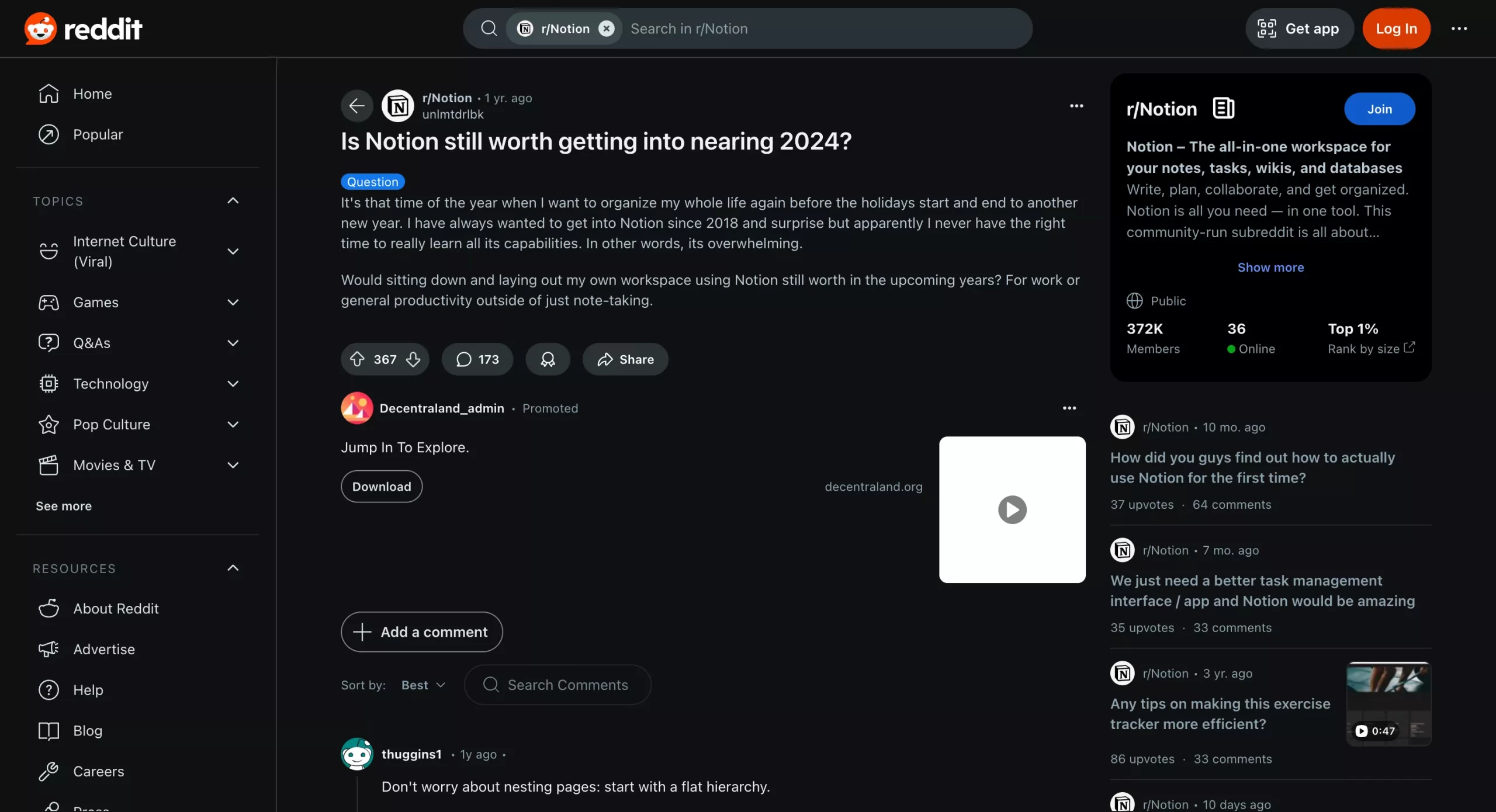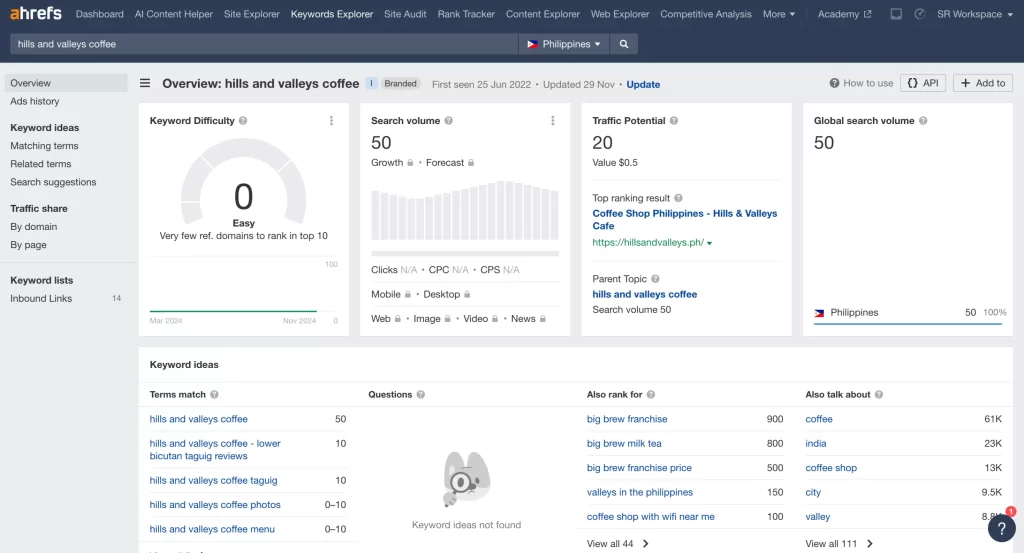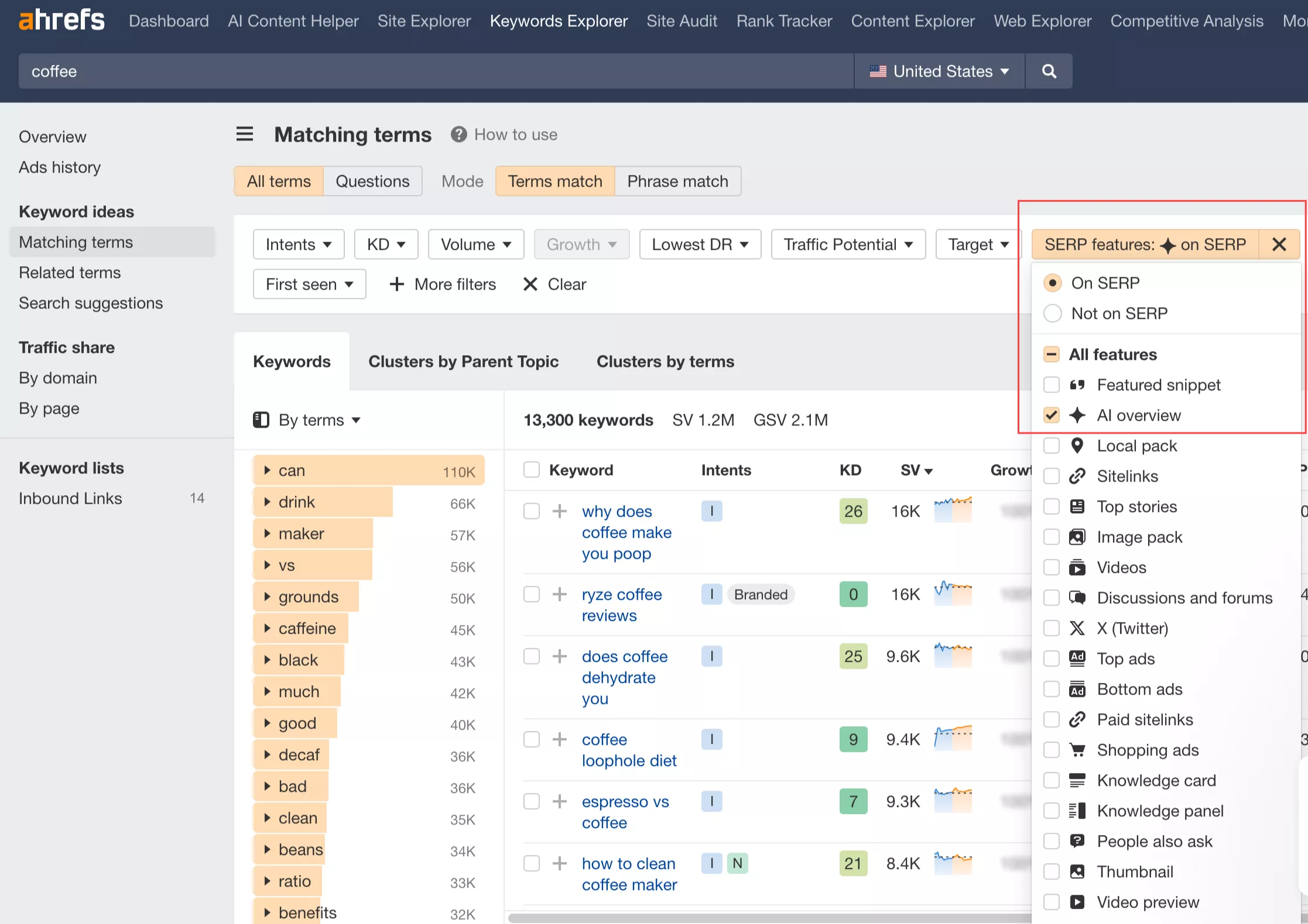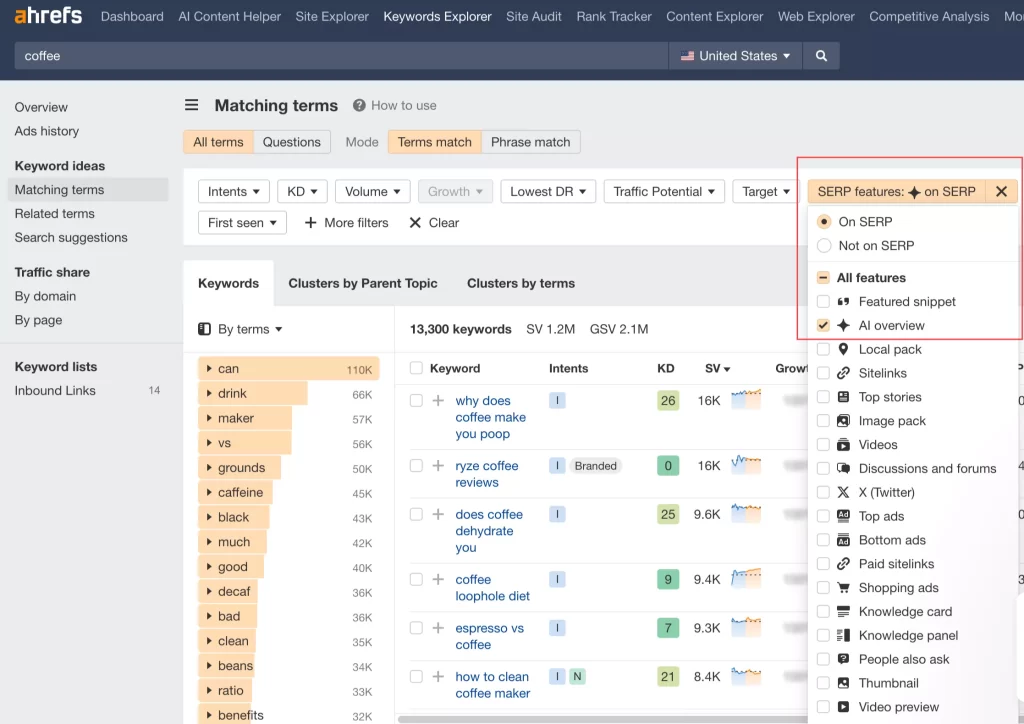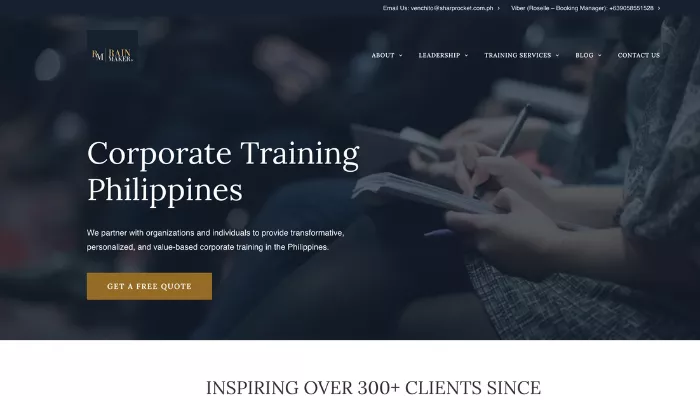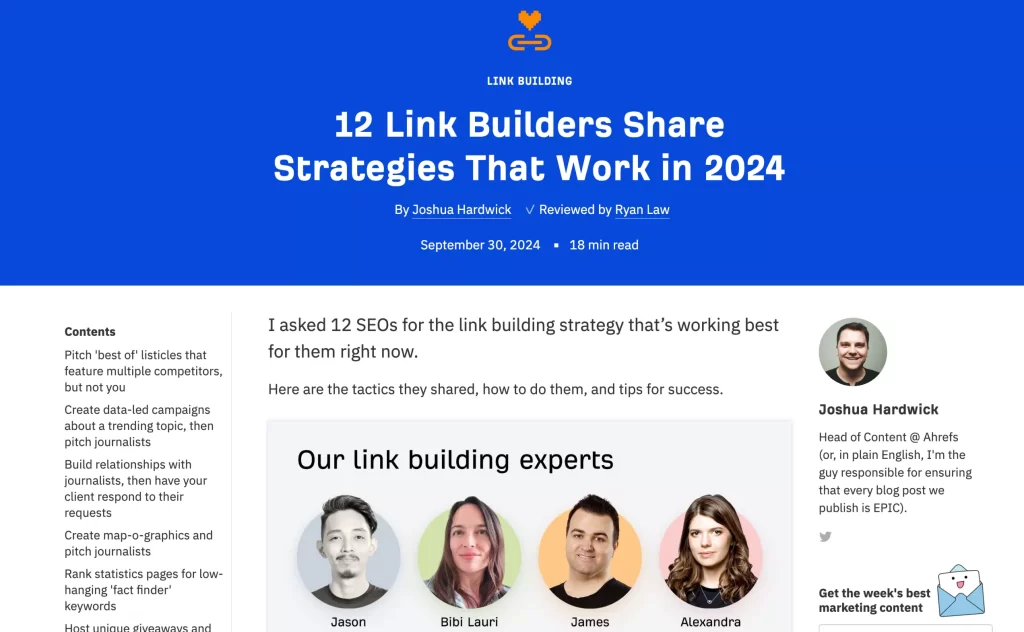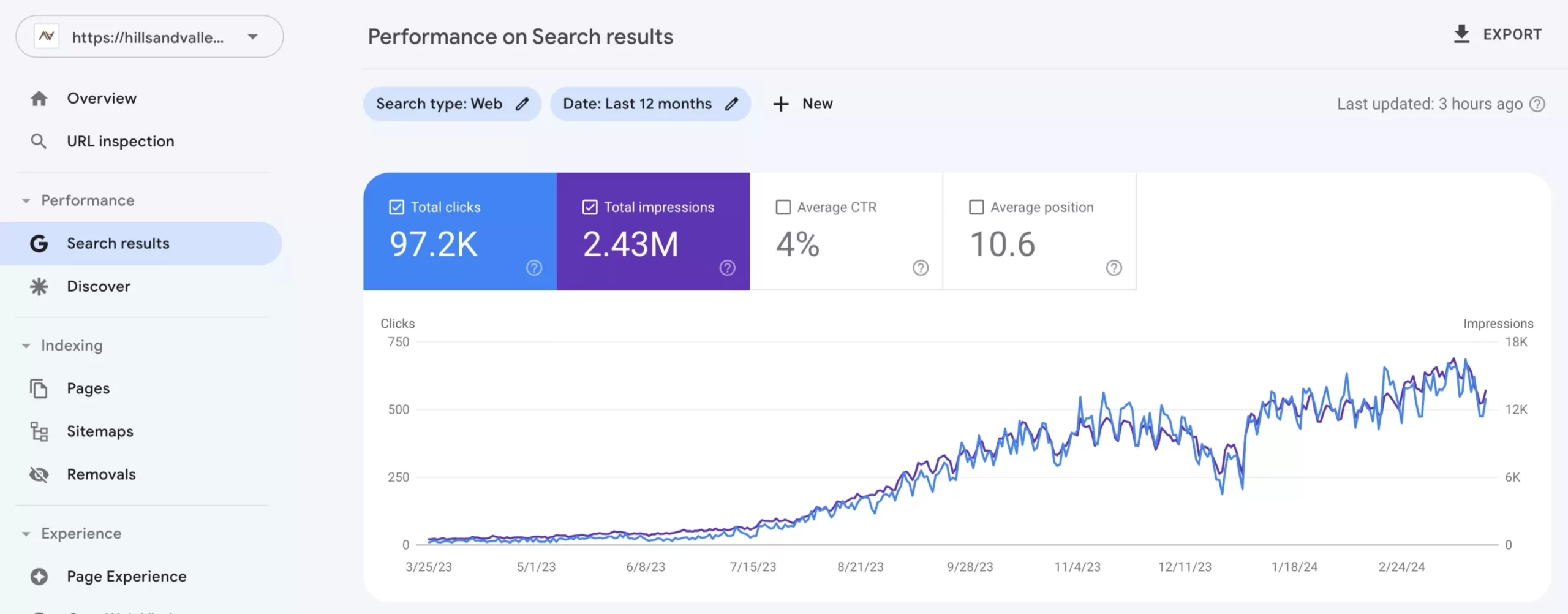How to Build Topical Authority in 6 Proven Steps [w/ Examples]
Google obviously favors brands because people trust them, which results in favorable rankings on search engine results pages (SERPs).
As established brands benefit from strong domain signals, they consistently receive branded searches, multiple brand mentions across the web, and a robust backlink profile, with several authoritative sites referencing their work through inbound links.
We even see average content hosted on high-DR sites ranking within days of being indexed, demonstrating the power of branding in SEO.
But what if you're doing SEO for new websites?
It's often an uphill battle to compete against search giants in your industry. It'd take years, let alone the resources you have to invest appropriately to ensure you're getting the right ranking spots.
The best way to approach your SEO strategy is to go narrow and deep, rather than trying to rank for every head term. You hyper-focus on one topic cluster at a time, covering every relevant subtopic with helpful content.
Not only are you sending relevant signals to search engines this way - about the clarity they need to associate your website with a given area of expertise. But as your topical coverage grows, so does your brand visibility, trust, and ranking potential (to even rank for more competitive keywords).
How to Build Topical Authority?
Below are the steps to build topical authority from the ground up, with examples from our own test sites to show you how it works:
1. Organize Your Content Using Topic Clustering
One strategic SEO approach is to create topic clusters to plan out your content and create a smart internal linking structure.
Topic clustering is an SEO-driven content strategy that organizes content around a central theme by linking a main pillar to multiple supporting cluster pages. Each cluster article (also called "clusters") targets a specific subtopic, while the pillar page (also known as "main hubs") covers the broader theme.
Topic clustering is critical when building topical authority, as it helps:
- Strengthens your position for AI search - AI crawlers look for authoritative sources when scraping content, so establishing yourself as a trustworthy source through complete topical coverage can increase the likelihood of surfacing in AI results.
- Improves topical relevance - connecting related content strengthens Google's perception of your site's expertise on the subject.
- Better UX - your target users can easily navigate to what they're looking for, between related articles (increasing time on site and user engagement).
- Smarter internal link equity - easily do internal linking between main hubs and cluster pages, distributing link equity across your site, assisting more important pages to rank for their individual keywords.
- Fills content gaps - covering all relevant subtopics that address every stage of the user journey and search intent, particularly those near the buying decision stage (MOFU and BOFU).
- Improves crawlability - a clear cluster format makes it easier for search engines to crawl and index your content.
If you want to go deeper with these, here are extensive resources on topic clustering:
Organize topic clusters in a spreadsheet (or any project management tool) by including the target URL structure, content format/type (i.e., list type, guide article, review).
You can also use AI to automate the process by giving you actual topic clusters you can actually use (or just use as an inspiration for your target content topic).
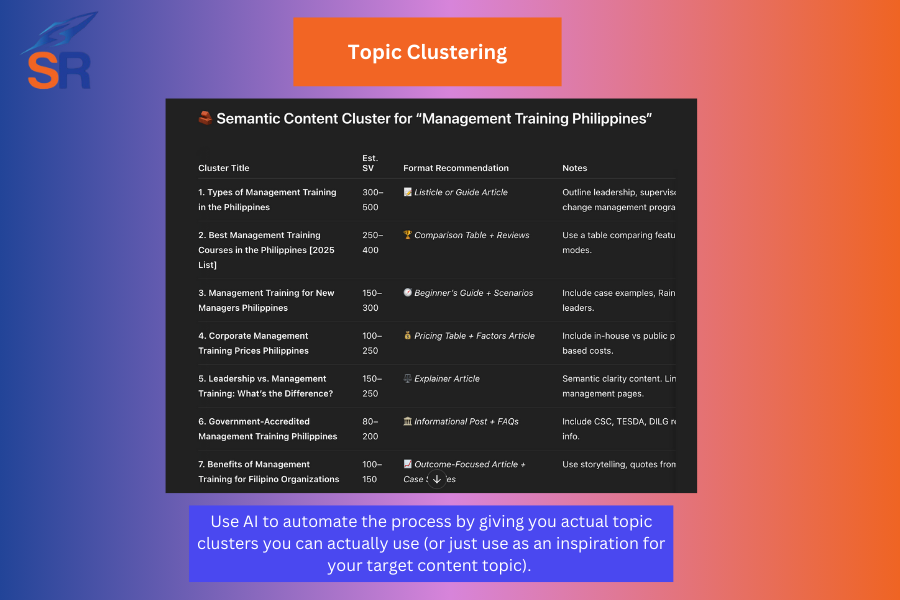
You may also want to match it to keyword research tools, such as Ahrefs or SEMrush, to get a quick look at the current search volume for each topic. It will give you ideas on what keyphrase to optimize each cluster page for.
Use your human judgment when picking cluster topics, as you don't want to base it solely on search volume. In many cases, most subtopics may have lower search volume, but they are significant enough to create content around (as they will cover a content gap in the industry compared to your competitors).
2. Build Strong Pages with Proper Topical Structure
Once you organize your topics into clusters, the next step is to structure each pillar and cluster page properly.
Structure the page around the searchers' intent, needs, and semantic expectations. And the best way to start is to do a Google search for the topic you're writing about.
Come from the perspective of a typical Google user, and ask yourself, "What exactly am I looking for this topic?".
Jot down ideas and let them inspire you when structuring your content for satisfaction.
Here's how we structure our content for maximum topical strength.
Satisfy Search Intent.
Placing the most important points at the top of the page is one way to satisfy your searchers' needs. Avoid burying the main answer deep inside your article.
Summarize key takeaways early, using clear lists, TL;DR sections, or quick bullet points, just make sure the search can easily find what they're looking for. By doing so, you reduce the chances of searchers pogo-sticking (bouncing back to the search results and finding another relevant page, which indicates you didn't meet the searcher's intent and needs).
Make a Succinct Content Outline
One of the fastest and most effective ways to build a comprehensive content outline is to study how top-ranking pages organize their content. At the very least, Google has ranked this content. Having your asset matched to what's already ranking is a good way to start - then improve it as you go.
You can use free tools like Detailed.com to instantly view the meta tags, H1s, H2s, and key structural elements of the top-ranking pages for your target query - you'll do so by individually going to each page in Google's SERPs.
Rebuild a similar structure but make it more comprehensive by addressing deeper needs, as well as adding additional headings and subsections that the top pages may have missed.
There are several content optimization tools available that automate the entire process; a few notable ones include Surfer SEO and Ahrefs' AI Content.

Incorporate FAQs and FUQs
Adding FAQs has been a standard for many publishers, which I sometimes think they have used only to make content longer without adding substance to the topic.
But you can actually go deeper in your content by adding FUQs (Frequently Unasked Questions).
FUQs are questions that users haven't asked widely yet but are likely to as the topic matures or user sophistication grows.
These are also types of questions that are starting to surface more often inside AI-driven searches. And by incorporating them early on, you get the benefit of making your content more discoverable for future new PAA boxes and emerging searches on both traditional search and AI.
One of the best tools for finding FUQs, especially on bottom-of-the-funnel pages, is Xofu, a new tool created by the Citation Labs team.
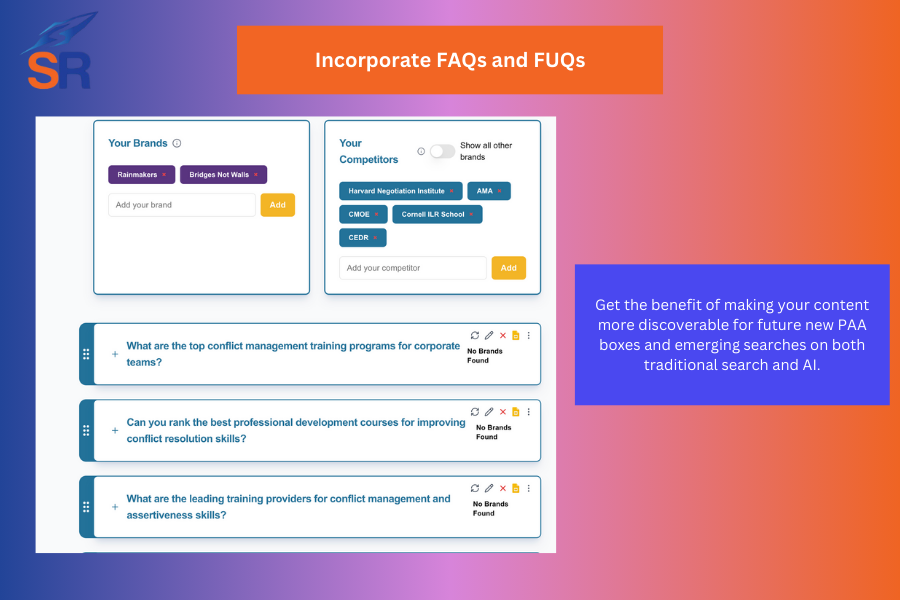
You can also use AI to scan for related but less common questions when you search your topic (use your human judgement based on your audience research, which topics are worth incorporating in your content).
3. Expand Content with Greater Topical Depth
As the term suggests, topical depth means covering a subject thoroughly across all layers of user intent, experience levels, and situational needs. And by accomplishing this, you develop your website into a comprehensive and go-to source of information in your space, giving other publishers a reason to cite you when writing their content.
You can start with the most basic method, which is to align your content to different stages of the marketing funnel (TOFU, MOFU, and BOFU).
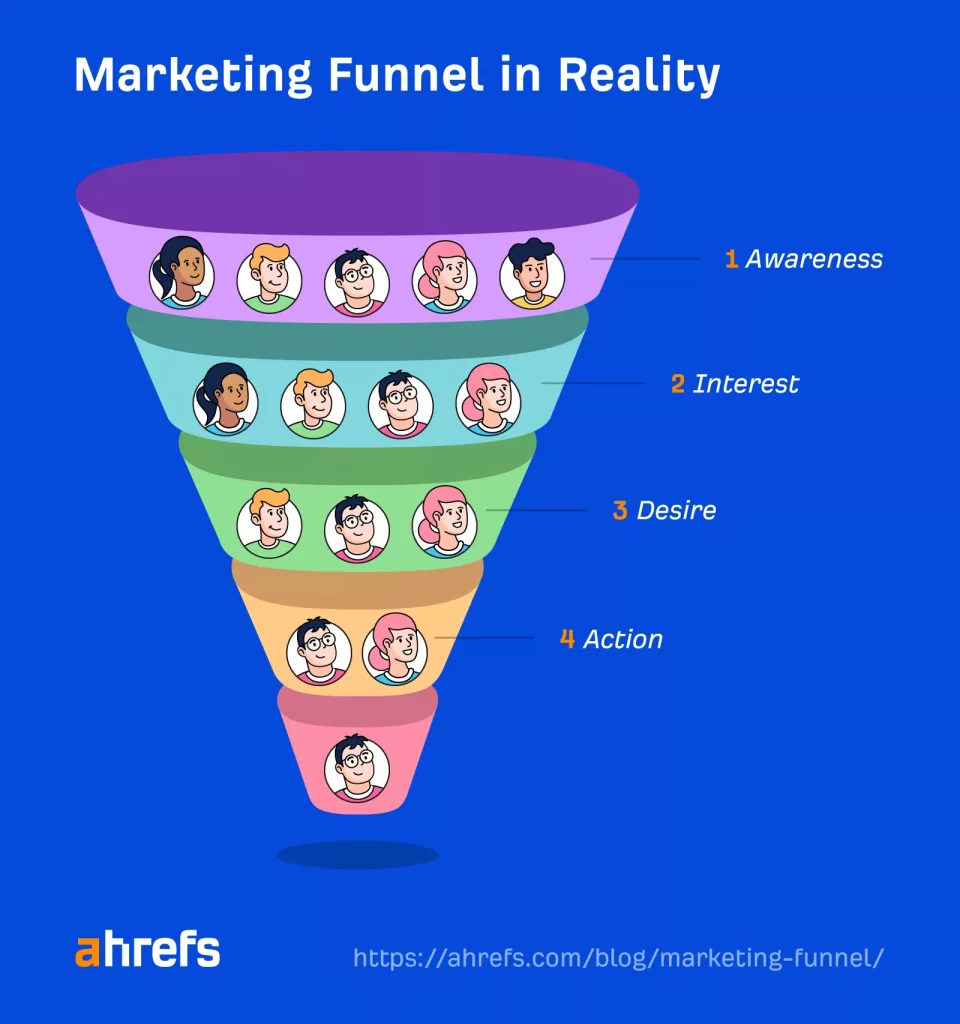
Although we've focused heavily on creating conversion-oriented content lately to maximize SEO investment (i.e., MOFU and BOFu content), as it not only captures significant search traffic but also actual organic revenue.
Publish Next-Step Guides
I learned this from Jason Acidre, who found that targeting higher expertise levels is an effective way to differentiate your content from other competing publishers, as most are now targeting beginner audiences.
You can start with introductory guides to capture entry-level searchers, but have follow-up layers of content assets for intermediate and advanced searchers.
This is also a good way to do internal linking by offering your beginner's guides the next steps of learning (i.e., 102).
Include Microsemantic Details
What is microsemantics?
Microsemantics refers to the fine-grain pieces of information that real users often include when they search, including numbers, audience types, locations, timeframes, and specific use cases.
These are exact nuances that your competitors may have missed in their content, but will be your true advantage if you've taken the time to include them in your page.
By strengthening semantic connections within your content, you help search engines better understand the full scope of your topic, which in turn increases your site's topical relevance.
Readers would also instantly recognize that your content is tailored to their real-world context, as you speak to the exact scenario they're currently facing, making your content more engaging and reliable to consume.
And with how AI has evolved through deep research, you give your pages a better chance of being cited during deep AI-driven content scraping and synthesis (you appear in deep research answers from AI).
Here are examples of microsemantic elements you can insert into your content:
- Price ranges (e.g., "Management training programs typically cost between ₱50,000 to ₱120,000 for a 2-day course in the Philippines").
- Timelines (e.g., "Participants often see improvements in leadership skills within 3 to 6 months after completing a management training program").
- Industry examples (e.g., "Management training tailored for the healthcare sector vs. retail industry").
- Professions or user types (e.g., "Best management workshops designed for newly promoted supervisors").
- Geographies (e.g., "Demand for management training in Metro Manila and key provincial cities in the Philippines").
- Target audience specifics (e.g., "Leadership courses focused on frontline managers handling customer-facing teams").
By delving deep into your content's topical structure with microsemantic details, you increase your site's EEAT signals, as only authors with expertise and experience can dissect information and clearly identify what truly matters to their target audience in their content.
Cover Unique Angles
Identify what your competitors have missed and fill those gaps in your content. When your competitors usually stick to the obvious points just to increase word count (i.e., adding too many basic definitions, unclear how-tos, or surface-level advice), you take advantage by including unique sections, perspectives, or details that are not present yet in many competing articles.
Focus on missing elements, such as:
- Deep user cases or applications that competitors have not discussed (i.e., leadership training for mid-level managers)
- Contrarian views or alternative approaches that offer different solutions (best for niches with different ways to attack the problem - i.e, "home improvement hacks").
- Common mistakes or misconceptions that no one else is warning about/
- Share topics for new learning with other levels of the audience.
Most SEO professionals view content gap analysis as simply filling keywords that other competitors haven't covered yet, but it also primarily involves filling missing angles to make your content a stronger endpoint for searchers, thereby providing higher satisfaction for your target audience.
You can also use the missing elements above when writing your opening hook in your content, immediately capturing your audience's attention and showing them how your content differs from the rest, even without skimming the table of contents.
Include Entities
I won't delve into this since it's already covered in many SEO guides. Basically, you want to naturally mention relevant tools, brands, personalities, organizations, and key concepts within your content, as these real-world references can enhance the semantic richness of your page and help search engines better understand its topical relevance.
Create Your Own Frameworks (or Bundle Existing Ones)
Developing frameworks and models is a standard practice when crafting training designs for the talent development space, which I adopted as a critical component in content publishing. Whenever I create helpful content for my test sites and clients, I replicate the same content creation strategy.
One upside of creating frameworks is that they simplify learning for my audience, as they present the topic in a more strategic and structured way.
If you're looking for where frameworks make sense to create or bundle with, here are a couple of elements of topics where it matters the most:
- Stages - Making complex processes easier to follow, step by step. (Example: Leadership development mapped into Assessment → Planning → Implementation → Evaluation.)
- Tools - Grouping recommended tools into a framework simplifies decision-making and standardizes the execution path for users. (Example: Using DISC assessments, leadership simulators, and 360° feedback tools in a management program.)
- Metrics - Defining clear metrics inside a framework shows users how to measure success and track real progress over time. (Example: Tracking leadership promotion rates 90 days after program completion.)
- Timeframes - Time-based checkpoints structure expectations, helping users stay accountable to deadlines and avoid procrastination. (Example: Reviewing leadership reinforcement plans every quarter after training.)
- Benchmarks - Before-and-after comparisons fit naturally into frameworks, making improvements or gaps visible and motivating action. (Example: Comparing team productivity metrics before and six months after management training.)
- Critical Actions - Highlighting essential actions gives users a focused execution plan, rather than overwhelming them with general advice. (Example: Requiring 1:1 coaching sessions within two weeks post-training.)
- Progress Indicators - Milestone indicators within a framework reinforce momentum and show users how to recognize early wins. (Example: Completing leadership application projects within 60 days of training.)
- Scenario Applications - Scenario-based variations make frameworks adaptable, helping users apply concepts in different real-world situations. (Example: Applying conflict management techniques during team reorganizations.)
- Audience Variations - Tailoring frameworks to different audience types ensures relevance, personalization, and better user engagement. (Example: Offering different leadership tracks for supervisors versus senior managers.)
- Support Systems - Including support layers (like mentors, coaches, or peer groups) strengthens the framework by building accountability and sustainability. (Example: Forming peer learning groups for leadership trainees.)
- Outcome Expectations — Anchoring a framework around defined end goals keeps users focused on results, not just activities. (Example: Setting a target of achieving 80% manager satisfaction scores post-training.)
- Adaptations for Scale — Frameworks that adjust based on team size, budget, or resources make your models scalable across different user needs. (Example: Modifying leadership workshops for teams of 5 versus teams of 50.)
- Skill Progressions - Layering skill-building stages into frameworks helps users advance systematically from beginner to expert levels. (Example: Moving managers from basic delegation skills to advanced strategic decision-making over 12 months.)
4. Cover Topics Fully to Strengthen Topical Coverage
What is topical coverage?
Topical coverage is how broadly and completely your entire site (or section) covers all the important and related topics in a domain compared to competitors.
By widening your content scope, you increase your content gap against your competitors, helping you to capture a bigger search market by ranking for relevant keywords they're not currently dominating.
Content Gap Analysis
Start by analyzing the topics your competitors cover by simply doing a manual Google search for them, using the site:domain.com search operator and the topic keyword. Adjust your topics based on how specific or broad your site's content theme (i.e., the niche you're trying to build topical authority in).
You can also run a content gap analysis comparing your site against your top competitors. Use tools like Ahrefs' Content Gap Analysis or SEMRush to find topics your competitors are ranking for that you haven't covered yet.
Review your topic hub structure and identify where you can incorporate topics identified from content gap analysis.
Emerging Keywords
Emerging keywords are often early signs that your site is gaining more topical relevance for new queries for which your pages are currently ranking.
Go to Search Console to find keywords that are relevant but not fully addressed by existing pages, which deserve a dedicated content piece.
Anonymous Queries
Pro Tip: Uncover more queries your pages ranked for but haven't been revealed directly in Search Console. Use Ahrefs' Anonymized Queries report, located in the GSC section, to surface hidden keyword opportunities.
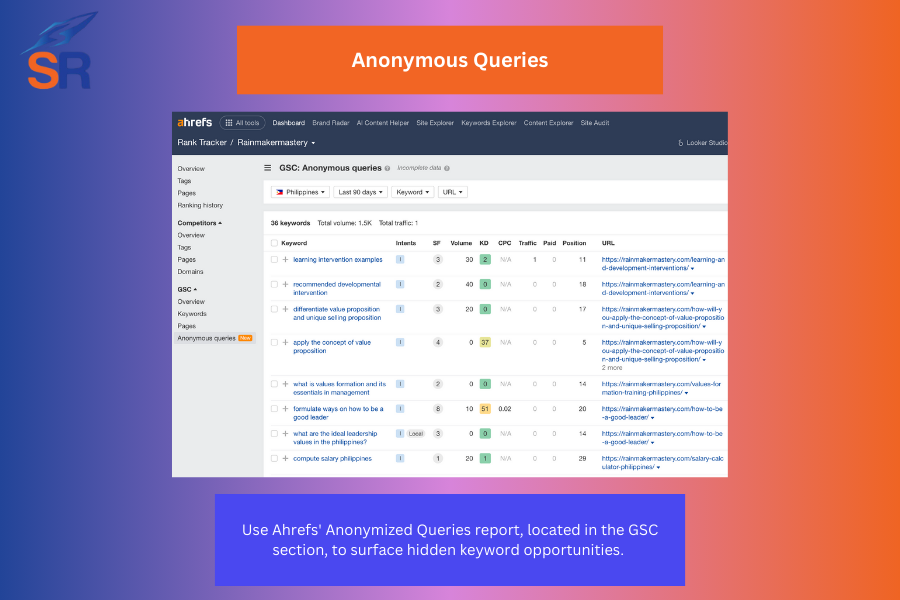
5. Increase Content Velocity to Accelerate Authority
What is content velocity?
Content velocity refers to the pace and volume of publishing, which is crucial for establishing topical authority.
Data-driven Approach to Content Velocity
Ross Hudgen's approach to estimating the target content volume each month is a strategic content marketing play. Given that you'll be investing resources in every content piece (research, time, design, etc.), it's essential to back up your efforts with data to ensure you're not just meeting random content volume goals.
Use Ahrefs' Organic Pages view to see how many valuable pages your top competitors are creating. Ahrefs only shows pages that it has indexed in its database and that appear in the top 100 keywords.
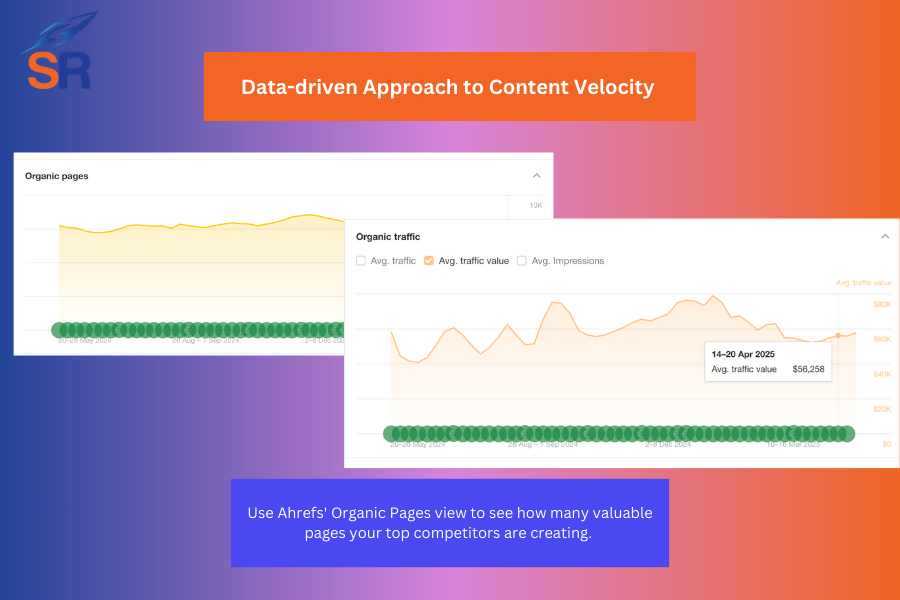
It's a good metric to see to help you plan realistically against your market. For instance, if a competitor is publishing 700 posts a year (that's around 58 new posts per month) - you can use it as one factor in benchmarking content volume.
Consider other relevant factors as well, such as traffic costs and your team's executional capabilities (how quickly your team can create content every month without sacrificing quality).
For traffic value or cost, you can use Ahrefs or SEMrush to see how much your competitors' content is worth. Then, tie your content velocity back to the number of relevant, high-quality topics that have business potential.
Lastly, consider how confidently your team can produce helpful content within the target volume. After all, you want to ensure every content piece passes your own editorial standards, so all of the pages would positively impact each other's rankings by building your site's topical authority.
Match Content Velocity to Your Site Authority
Another method to determine content velocity is to consider the reality of your site's authority (how many indexed pages do you currently have on your site for the topic (s) you want to build topical authority in)?
For a new or low-authority site:
Focus first on publishing content for winnable, low-competition keywords. You can use the "Avalanche Strategy", where you start slowly publishing content, capturing smaller topics, and building trust for your pages one step at a time.
Be careful not to flood your site with hundreds of pages overnight without quality control or topical structure.
Publish regularly at a consistent pace so that Google sees it as a sustained effort, not just a one-off.
For an established, high-authority site:
Larger content rollouts are viable for established websites (e.g., with 300+ pages over a few months), as Google already associates your domain with trust and relevance. You can expand aggressively into related topic clusters to further widen your topical authority while still reinforcing existing domain strength.
Refresh and Update Content
It's a strategic content marketing technique to increase content volume, but it's equally important to freshen and update existing content to maintain the topical strength of your site.
As you grow topical authority with new content assets ("outward approach"), you update existing content assets to satisfy searchers ("inward approach") - to continuously send positive freshness signals to search engines, which they reward through better rankings.
It would be easy if you had a couple of pages to update, but if you have a large website with hundreds or thousands of pages, which one should you prioritize for content freshness?
You begin by first identifying topics with a shorter content freshness distance. Use the Freshness Distance Calculator to estimate how critical content freshness is for a given search query or topic - do it for your primary keywords first, then eventually for your secondary keywords - ones that also critical to your business.

Then, organize it by adding a column for "freshness distance" (i.e, how many updates are needed to update the content).
Include it as part of your regular content audit to first look at pages with the shortest freshness distance.
6. Micro-Authority Link Building
If you're a fan of this blog, you've heard me say this several times, that link building can significantly impact your topical authority, as you build links (votes) from other trusted and authoritative websites (which Google considers to be a strong factor in determining which site is a credible, real, and trustworthy).
I've written several link building guides on how to build backlinks:
But here are the ones you may want to explore in building micro-authority through link building:
- Get exposure and relevant links by appearing on niche podcasts in your space. You can pitch to be a guest or have your allies interview you on their podcast shows.
- Attract interview opportunities by being active on social media platforms and responding to topical, relevant questions through social commenting. With this, you're building radars for mid-level influential content creators to invite you to their show or ask you pertinent questions for their content.
- Publish more linkable assets to show expertise and build your personal brand - ensure you have a solid author bio that showcases your experience and expertise as an author and industry leader.
Topical authority is built brick by brick, not overnight. It is a combination of many positive actions, including publishing content assets that serve users' needs and intent, as well as gaining backlinks from trusted, authoritative sites.
Need link building? We help you earn high-quality, contextual backlinks that strengthen your topical authority and drive sustainable organic growth. Get our link building services.
Reddit SEO: How to Rank in SERPs Using Reddit Content?
Reddit is at its all-time high in the ranking for variants of keywords across different industries. We don’t know for sure when it will last, but jumping on this bandwagon is a slightly minimal effort you can make to get some of Google’s real estate for your target keywords.
According to a Wix article, Reddit has officially opened its doors for brands to do business. Being at “the front page of the internet”, Reddit is a hub for in-depth discussions, trusted reviews (assumingly), and niche insights. It becomes an invaluable resource for businesses looking to improve their search rankings.
In this guide, I’ll share actionable tips on leveraging Reddit SEO, whether you’re trying to rank a niche hobby site or a B2B SaaS client.
Use Reddit for Keyword and Topical Research
Reddits’ subreddits are among the best sources for reverse engineering potential keywords in your industry. Given that the intent of users is to look for solutions to their problems or ask for experiential insights into what product/service to choose, the keywords subreddits may be ranking are strong indicators of what actual users search for.
Start by finding subreddits relevant to your niche. You can use Reddit’s search bar, a quick Google search for site:reddit.com [topic], or third-party tools like Keyworddit to uncover active communities.
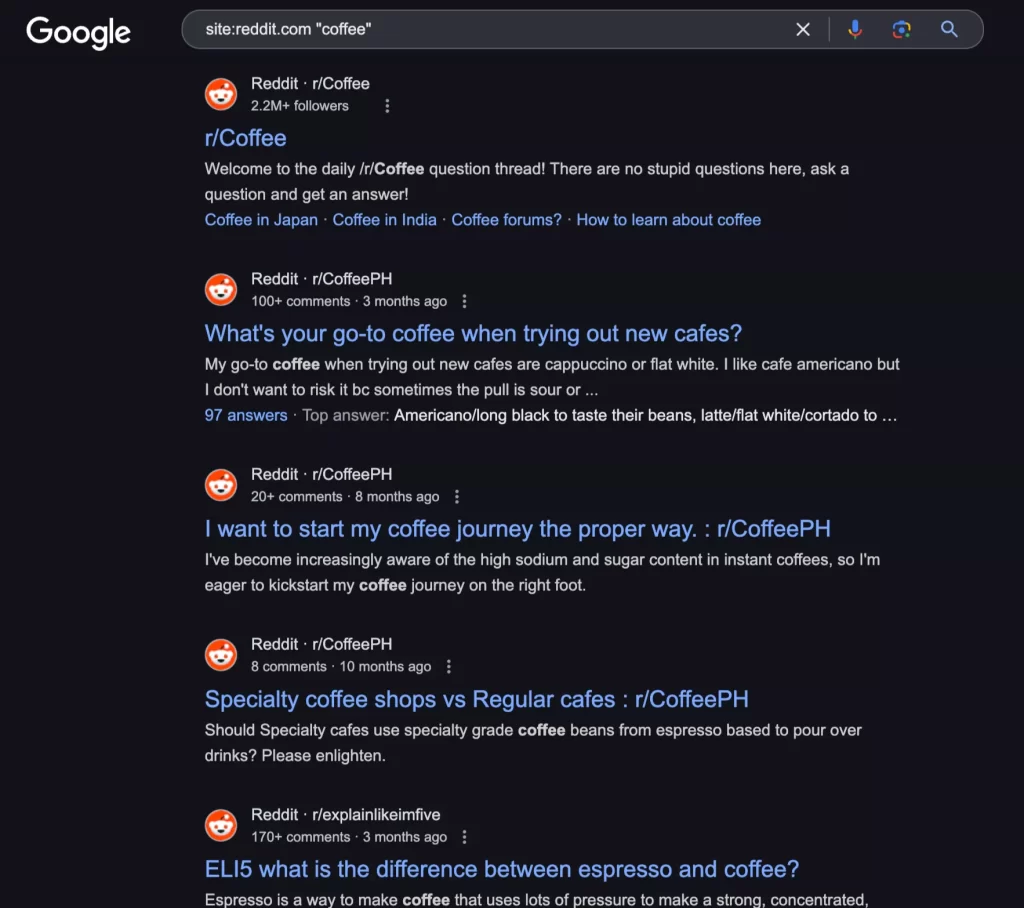
Whichever method you use, the key is to find communities with high user engagement. For instance, if you’re in the finance sector, subreddits like r/PersonalFinance or r/Investing are excellent starting points.
The next step is to dive into threads with high upvotes and engagement to identify trending topics. Focus on the language your target audience uses to frame their questions or problems. For example, a thread titled “What’s the best alternative to Notion for project management?” signals intent and potential long-tail keywords like “Notion alternative”.
Another best way to generate keyword insights from Reddit is to use tools like Ahrefs or SEMRush to analyze the organic keywords driving traffic to Reddit pages.
Here’s a simple process:
- Enter "Reddit.com" into Ahrefs’ site explorer.
- Navigate to the “Organic Keywords” section.
- Filter results using seed keywords from your niche (e.g., “pet food” or “cloud storage” or “coffee franchise”).
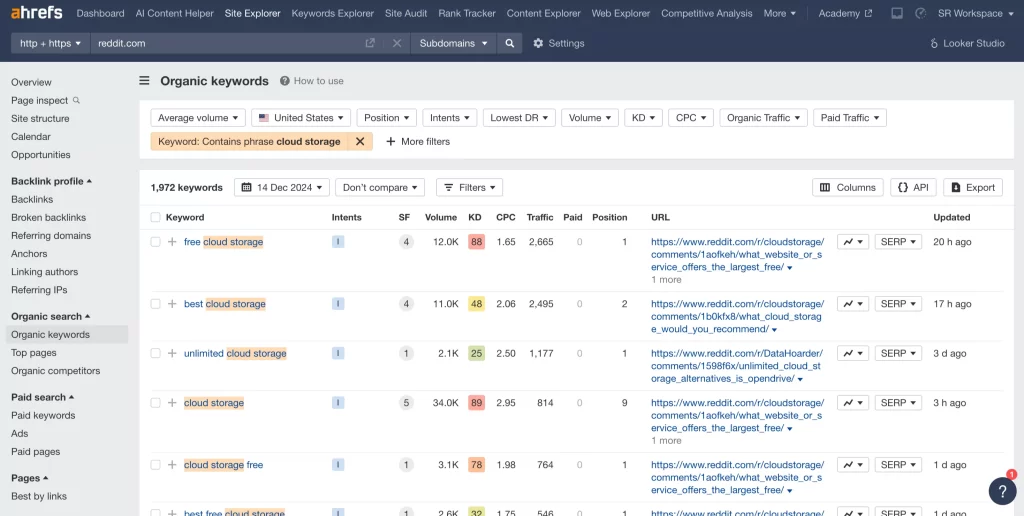
This is useful in uncovering keywords with significant search traffic but with higher conversion potential.
Answer Questions to Solve Problems
The last thing you’ll do on Reddit is self-promote your products/services whenever you want to. This is one of the pitfalls of using Reddit, as Redditors (users and moderators) are quick to downvote or flag overt self-promotion.
The key to succeeding in Reddit content engagement is to focus on providing value without pushing your agenda quickly. When done right, subtle mentions of your brand or product can generate curiosity and brand search volume and can lead to actual organic traffic.


Remember, the context in Reddit is that users visit it to find answers they trust, whether it’s for product recommendations or technical advice. So, having this mindset as the start can become a game-changer in engaging in Reddit.
Here’s how to make the most of this value-adding contribution:
Start with your brand. Your customers (or potential customers) may be asking about anything about your products/services (features, benefits, results, comparison, etc.). Answering specific questions from your potential customers can help you overcome their objections and let them make a purchasing decision.
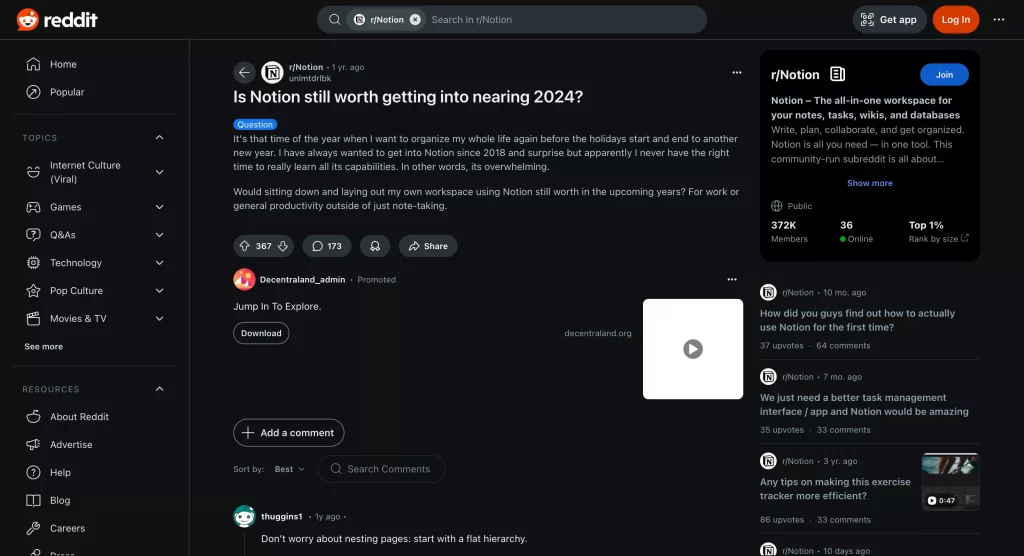
Do it with finesse, as you don’t want to overhype your answers. Answer truthfully by tackling the angles of your product offering at which you’re best. This can also help you strategize positioning your product’s POV in your link building campaigns.
Focus on intent: Engage with questions directly tied to your industry or expertise. For example, in SaaS, a question about the best task management software could lead to an opportunity to discuss the features and benefits of a product your brand offers. You may expand your content theme as long as it is within your industry.
By thinking of the ‘why’ users are asking these questions, you’ll deliver the answer in a way that addresses their pain points.
Comprehensive answers: Posts that provide detailed, helpful answers are more likely to be upvoted and indexed by search engines. For example, a well-written response on r/PhInvest addressing the pros and cons of coffee franchise investments could rank highly on Google.
The comprehensiveness of answers doesn’t mean lengthy ones. It could be concise as long as you answer the question right. Similar to how you create and publish helpful content for search, it’s the same mentality you have with Reddit insights.
Increase Brand Search. It’s one of the upsides of answering questions on Reddit, as it helps increase curiosity and naturally encourages users to search for your brand on Google. As you know, getting more brand visibility helps your website's overall rankings, given that they favor more brands today than ever (and in 2025, as one of the SEO predictions by top SEO experts).
Bring Expertise to Reddit
EEAT isn’t just a myth. It can help you climb your pages in Google’s SERPs and establish authority and thought leadership in your space.
Imagine seeing your brand as a source of consistent, value-driven answers. You’re increasing your chances for more brand visibility (search volume, as mentioned earlier) and assisting in future collaboration with other publishers and content creators in your industry.
Here’s how to bring EEAT to Reddit:
Make in-house experts involved in content promotion. You don’t have to hire outside collaborators (you may do so if it’s possible with resources), but you can start with tenured people in your organization.
Given that SEO today requires collaboration between many departments (and not just marketing), partnerships with product management, research and development, and the management team help you acquire first-hand knowledge and experience you can leverage to answer Reddit questions.
Email your in-house experts with industry-related questions and answer Reddit threads with your account. Explain why they need to do so to get more buy-in for your initiatives. This could also helpful you in other link building strategies such as niche edits and digital PR campaigns.
Another way to bring expertise to Reddit is to back up your claims with statistics, studies, or personal experience. If you have internal data, surveys, or industry reports that are helpful to the community, link to any of those pages in your Reddit answer. It’s a good way to promote your brand without overtly self-promoting it.
Track Competitors and Market Sentiment
As a multi-industry entrepreneur, tracking competitors' and customers' feelings about their offerings is a silver-lining strategy. You get to observe discussions about your competitors, gauge the market sentiment, and uncover pain points or needs unmet by their brands.
Threads like “[Competitor] Is it worth it?” can give you insights into customer opinions and concerns. You can incorporate these points into the customer-centric copy on your blog content and landing pages, increasing conversion rates.
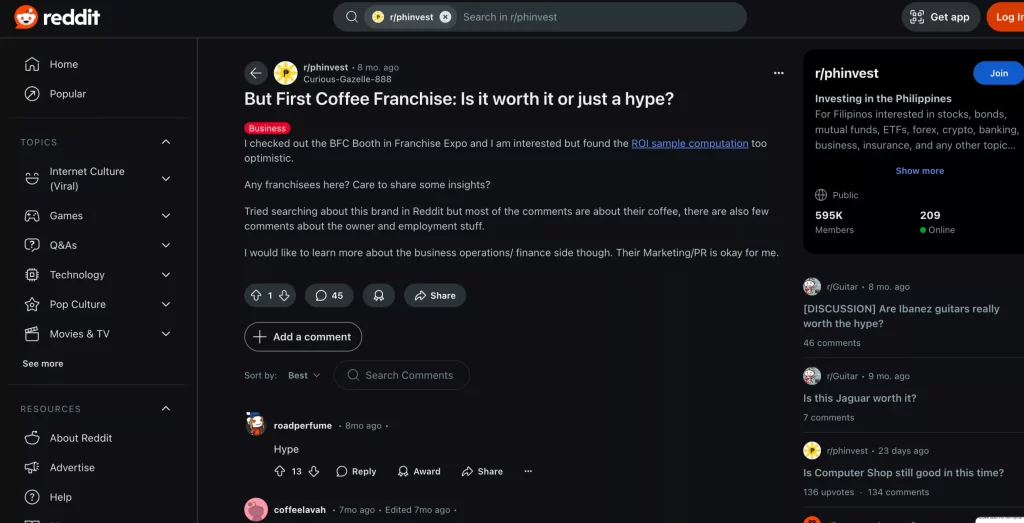
It’s also a good way to publish blog content for questions that may not have significant search volume (or zero search) but are likely getting interest from your target audience. I got this from Koray Tugberk, who said publishing zero search volume with high interest in the offline world can increase your domain's topical authority.
Include Reddit in Your Blog Ideation Strategy
In the SEO world, we’ve got dynamic keyword research strategies from reverse engineering competitors or topical map creation using Ahrefs or SEMRush.
On one side, you can actually utilize Reddit to flesh out new blog ideas straight from ranking subreddits.
Begin by plugging Reddit (or a specific subreddit) into Ahrefs or SEMRush. Then, analyze the organic keywords for which these pages rank.
You can filter to match significant search volume (say 100<) and tie it to your current site authority to choose keywords for keyword difficulty. For instance, if you have a DR50+ site, you can select keywords with medium competition, as you’ll have chances of competing, given your domain authority.
Whenever you run out of techniques, it could be a good practice to use Reddit’s keyword research strategy.
Another upside of incorporating Reddit into your blog strategy is thinking of upgrading content formats with questions from Reddit. This helps improve the page’s EEAT quality and its ability to attract passive backlinks, as you provide more first-hand experience and original expertise to the subject discourse - assuming you provide the best answers possible to those questions.
Real Estate Domination on Google
Given that Reddit ranks for many keyword variants in different industries, you’ll have an opportunity to appear in several threads, apart from your ability to rank for your target head terms with your web pages.
Today, ranking on multiple list pages and community pages (including subreddits) is more important than ever for increasing brand visibility.
Content Strategy and Link Building for Google AI Overviews
As search evolves, the rise of AI overviews in Google results brings fresh opportunities for visibility, but the fundamentals remain the same. While it’s not about optimizing content solely for AI, a strong SEO foundation enhances your brand’s presence across all search experiences, including AI-driven results.
The essentials of SEO—well-structured, unique, and genuinely helpful content—continue to be the bedrock of visibility. However, as digital marketers aiming to build authority and relevance, we can consider AI Overviews as an additional layer that increases brand exposure.
AI overviews offer the chance for brands to surface in a different light, adding an opportunity for expanded visibility in high-quality content spaces.
Content Strategy and Link Building for Google AI Overviews
Developing a solid link building and content strategy is pivotal to achieving the right positioning in AI overviews. The key to success is consistently updating content to match user intent, answering complex queries, and designing content that fulfills user needs.
1. Monitor SERP Features for Target Keywords
Monitoring SERP features helps you stay competitive. Some queries now feature AI-generated summaries, videos, images, and other multimedia elements. For example, Google may display a “People Also Ask” section, AI-generated overviews, and even knowledge panels for specific keywords.
Tools like Ahrefs, and SEMRush can identify which keywords yield SERP features, like AI overviews, that may benefit from multimedia content additions. This data enables you to adjust your content by incorporating structured data, images, or videos.
2. Creating High-Quality, User-Focused Content with EEAT
High-quality content, especially when structured for user engagement, enhances your visibility potential across search types. Google’s EEAT (Expertise, Experience, Authoritativeness, and Trustworthiness) are critical for ranking in AI-driven search.
Focus on creating original perspectives that add value (information gain), grounded in genuine expertise and real-life experience. Google’s AI algorithms identify rehashed content and can now better recognize authentic, informative resources.
Showcase your expertise by weaving in firsthand examples, studies, and insights that differentiate your content from competitors. Content that draws from expertise is more likely to rank and appear in AI-driven summaries.
3. Deep Dive into Audience Research and Core Topics
In-depth audience research is non-negotiable in aligning content with user intent and needs. Google’s ranking systems now prioritize content relevant to a website’s primary purpose. Publishing content that strays from core topics risks diminishing your authority in Google’s view.
Create audience personas to understand what your audience values. Develop content around these insights to ensure they resonate and fulfill their needs.
Ensure each piece of content addresses your audience’s pain points and challenges. If your site focuses on digital marketing, avoid publishing unrelated topics, as Google now distinguishes unrelated content sections within a site.
Google recently noted a shift in visibility for sections of sites like “Fortune Recommends” and “Forbes Advisor” due to disjointed content that wasn’t fully aligned with each site’s primary theme.
4. Link Building That Complements Core SEO
Backlinks remain crucial for reinforcing authority, yet placement has become more strategic in AI. Here’s how to build links that serve both organic search and AI-driven summaries:
- Be strategic in placing links on entities and sites you want to be topically associated with your brand.
- Consider sentiments in the context of the page's/content's overall message. Ensure they promote a more positive perception of your product/service and do not work against your offerings.
- Be on the lookout for links/resources/where-to-buy pages that can demonstrate your products' POV as they get included in the lists pages.
- Make quality control part of your process when checking the entire context of the page/content from which you aim to get links. Not only is it relevant to your site, but it must also help improve the association toward solving problems your prospective customers are experiencing.
5. Optimize Content for Complex Queries
With generative AI allowing users to ask intricate questions in one search, optimizing for query chains—consecutive follow-up questions—is more effective than targeting isolated keywords. By addressing connected topics, your content appears more thorough and relevant.
Write comprehensive guides that anticipate follow-up questions. For instance, if you write about “digital communication skills for HR,” also consider covering “how digital skills benefit talent development” or “common challenges HR faces in digital communication.”
By structuring content with linked topics, you increase the chances of AI identifying it as useful for multi-layered searches.
6. Publish Short-Form Videos Directly on Your Site with Structured Data
While platforms like TikTok, Instagram, and YouTube are popular for short-form video content, don’t overlook the value of hosting these videos on your website. Tools like Wistia can enhance video quality and user experience on your site.
By embedding videos directly, you keep traffic on your domain and have better control over the content’s SEO impact. Additionally, mark up your videos with structured data to make them more discoverable in Google Search and eligible for inclusion in AI overviews.
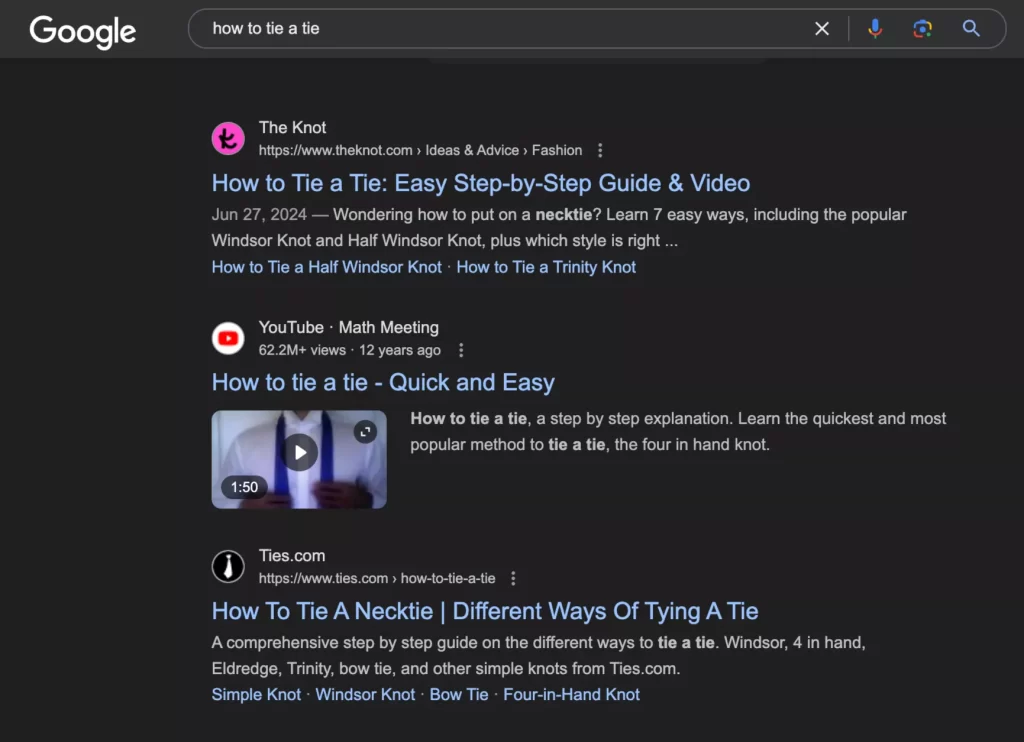
Embed product demos, explainer videos, or testimonials directly on relevant landing pages and use structured data to signal their relevance to Google. This can improve visibility in both standard search results and AI-driven summaries.
7. Enhance Sales Pages with FAQs and FUQs (Frequently Unanswered Questions)
Adding FAQs to your sales pages immediately answers common customer questions, enhancing user experience and optimizing for AI overviews. FUQs, or frequently unanswered questions, address nuanced or lesser-known queries, showcasing your in-depth expertise and understanding of the customer journey.
Identify customer pain points and unique questions that arise during the sales process. Incorporate FAQs and FUQs into your content strategy to address these needs proactively. This thoughtful design positions your content as a comprehensive, reliable source in current search results and evolving AI landscapes.
Positioning Content for Future Search Landscapes
Incorporating these practices prepares your content for success in an evolving SEO landscape, where AI-driven summaries may soon become more prominent. By blending traditional SEO with AI-conscious content practices, you build an adaptable content strategy that remains resilient in a changing environment.
The essentials—quality content, strategic link building, and user-focused design—create a content approach that thrives in AI and traditional search results, establishing your brand as a trusted source.
SEO-Driven Content Marketing For Startups
Create content that ranks and converts.
SEO-driven content marketing aims to rank pages and engage users so that they will convert.
While most SEOs vouch for just rankings, I do believe that content marketing activities should impact the business goals and objectives ─ and any marketing activity, for that matter.
In this guide, we’ll explore tips on utilizing content marketing for startups to drive SEO impact to your website.
1. Turn Audience Research to Content Clusters
Start by understanding the needs, interests, and challenges. This can involve creating a buyer persona that speaks to the demographic and psychographics of your target audience. Getting fresh data from your management team can also help pinpoint who your customers really are.
Create your ICP (Ideal Customer Profile), which describes your business' ideal customer based on common attributes like demographics, behavior patterns, needs, and pain points.
Then, use tools like Sparktoro or Ahrefs to discover topics and questions your ideal customers might be searching for to find solutions.
When looking for topics, ensure you tap into each stage of the marketing funnel (Awareness, Interest, Desire, and Action), or in the digital marketing realm, we have BOFU (bottom of the funnel), MOFU (middle of the funnel), and TOFU (top of the funnel).

Even if it’s not a product/service page you’re publishing, you can still convert customers on your pages in the TOFU funnel (informational pages) as long as you deliver solutions to their needs and contextually place a solid call to action on your landing pages.
Here are a few steps to building effective topic clusters:
- Identify Core Topics: Identify 3-5 broad topics that align with your startup’s services, products, or expertise. These will become your pillar pages.
- Conduct Keyword Research: Use tools like Ahrefs, SEMrush, or Google’s Keyword Planner to find relevant keywords related to your core topics with significant search volume. Pro Tip: Do not skip zero-volume keywords that must be part of your content marketing base.
- Create Subtopics: Based on the keyword research, identify subtopics that address various facets of the core topic.
- Link Your Content: Interlink your pillar page with cluster pages. Internal linking helps search engines better understand your priority pages and improves the crawling and indexation of your new pages.
For instance, If your startup offers project management software, your pillar topic could be "Project Management Techniques". Cluster pages could cover subtopics like "Agile Methodology”, "Kanban vs. Scrum”, and "Project Management Tools for Startups”.
Publishing these product-led linkable assets can also lead to more link building opportunities while driving new users to your product or service.
2. Enlarge Your Publishing Base Through People-First Content
People-first content is about creating valuable, relevant, and high-utility content that meets the needs and expectations of your intended audience.
We’ll examine these four critical components of people-first content (Jason Acidre’s framework).
Needs Met
“Needs Met” is about how well your content matches the searcher’s intent and fulfills their expectations. Here’s how to ensure that your content meets this criterion:
- Intent Matching: Ensure your helpful content answers the exact queries your audience is searching for. Use tools like Search Console to identify common keywords and adjust your content to fulfill informational or commercial intent. Avoid misleading click-bait titles that don’t deliver on their promises.
- Target a Single Topic & Intent: Focus on a single topic, providing clear and concise answers without overwhelming the reader. Avoid burying essential information in long, multi-topic content. Consider using separate pages for subtopics with significant search volume.
- Direct Answers to Main Queries: Present direct answers prominently above the fold using formats like Quick Answer Boxes, Key Takeaways, or Summaries. This approach caters to users seeking quick information, especially on mobile devices.
- Remove Fluff Content: Keep your writing concise and relevant, eliminating off-topic, redundant, or overly wordy sections to maintain clarity and improve user experience.
For instance, in every blog post I write for our corporate training blog at Rainmakers, I determine the user intent of each search query. Asking the question, “What do they want to know first?” helped me prioritize points (and put them above the fold) so it would immediately satisfy the user's needs.
Here’s a recent post on “What is leadership to you?” The searchers would likely be students and learning and development practitioners who are looking for different schools of thought on the subject.
I delivered what they needed, based on my expertise on the subject:
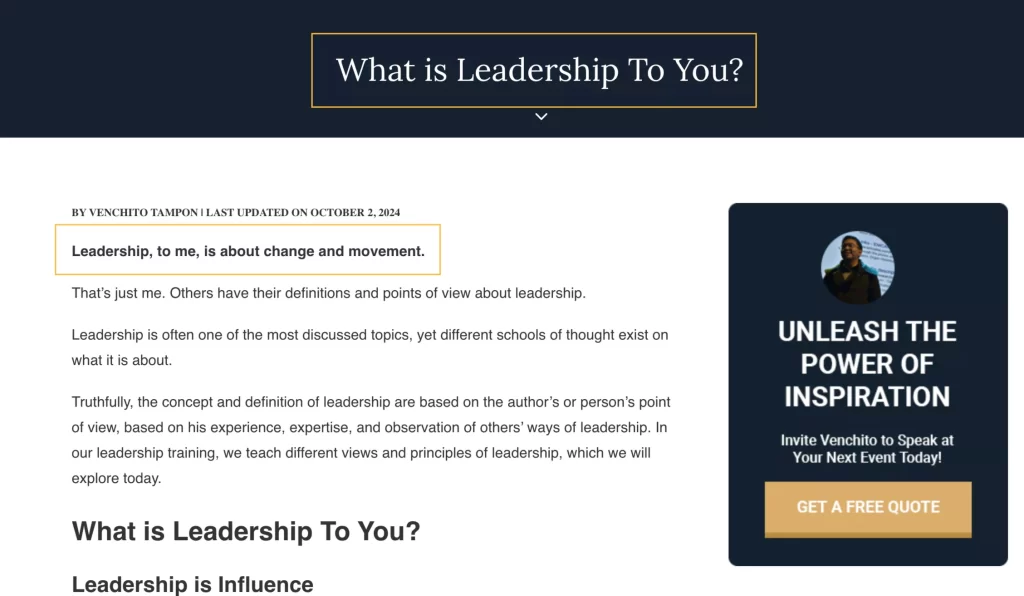
Another example is my coffee shop blog. We meet users’ needs by providing direct answers to certain questions (e.g., how much does it cost to start a coffee shop?).
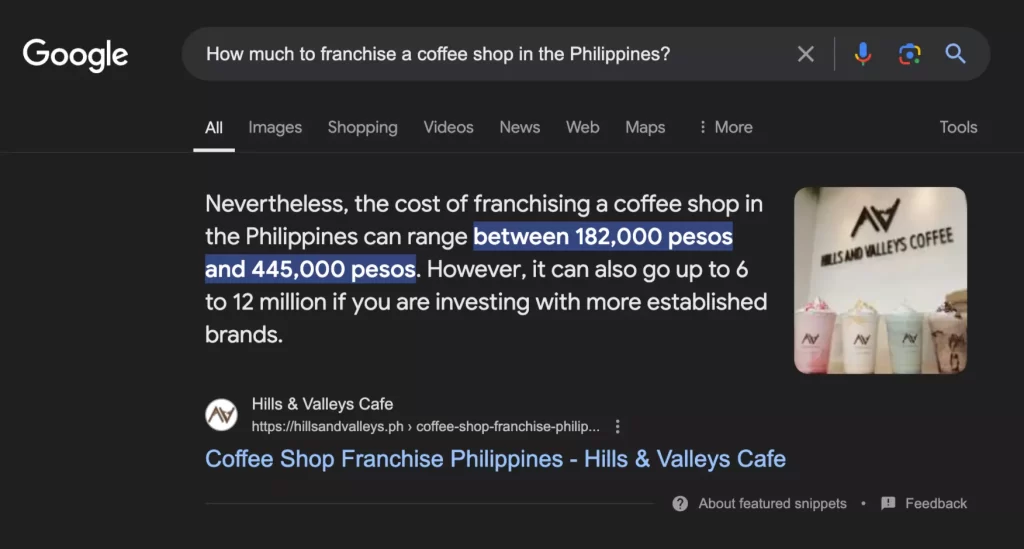
Now, this brings us to the next component of creating people-first content:
EEAT (Expertise, Experience, Authoritativeness, Trustworthiness)
By now, we should have known this populating all over SEO blogs. The ability to integrate EEAT into your content matters ─ here are few tips to leverage this:
- Comprehensive Author Details: Showcase the author's experience, expertise, education, achievements, and social media links to showcase their credibility (authorship SEO). A detailed bio builds trust and authority.
- Proper Sourcing & Citations: Cite reputable sources to demonstrate that your content is research-based and factual, enhancing trustworthiness and depth.
- Including Credible Stats or Expert Quotes: Incorporating statistics or expert quotes can boost content visibility and authority by 30-40%, providing evidence-based information that supports your claims.
- Accuracy of Information: Ensure your content is accurate, especially for industries like YMYL (Your Money, Your Life). Update facts and data regularly to maintain integrity and ethical standards.
- Editorial Process, Disclaimer, and/or Disclosure Statements: Include disclaimers, disclosures, or editorial policies to add transparency, authenticity, and clarity about the content’s intentions or potential biases.
Ahrefs has solidified its brand marketing by incorporating credible authors and experts to contribute insights and quotes to its blog posts, boosting the pages’ credibility and search performance.
Originality & Information Gain
Google emphasizes originality and information gain to combat the issue of copycat content. The goal is to provide unique insights that add value beyond existing content. Here’s how to enhance originality:
- First-Hand Knowledge: Share personal experiences, unique insights, or innovative ideas that address unmet needs. This will set your content apart and position your brand as an expert, potentially earning hard-to-replicate DR 90 backlinks.
- Original Research & Data: Conduct your research or gather data through surveys, experiments, or analysis. If you can't collect data, source it from public databases and present it from a unique angle to offer fresh insights.
- Provide Self-Sourced Images: Use original visuals like screenshots, branded infographics, product photos, or personal experience images to add authenticity and relatability. This makes your content more trustworthy and distinctive.
When incorporating experiences into your content, include what made you feel, see, touch, and taste ─ these are five senses only a person with actual experience on the topic can share in the content.
Give Depth To Your Content Assets
One of the WOSCON 2024 speakers, Kasra Dash, mentioned during the panel Q&A that building topical authority on a website requires publishing more pages within a relevant subject and achieving depth through topics that haven’t been published elsewhere.
Identify subtopics that could be expounded into single blog posts. Based on your expertise and experience, think of topics you can add more depth by giving more information on the “how-to” or new insights from real-world practice.
You can also publish internal data studies that align with topics to validate and support points. This is also an additional content asset that attracts new links to your page.
3. Build a Link-Earning Flywheel
Link building through manual outreach is becoming more difficult these days. Asking for inclusion or requesting a link requires newly contributed content and a solid reason for linking.
This is one primary reason why building a link-earning flywheel on your site gives you leverage to earn passive links without the constant need to do email outreach.
Here are a couple of ways to build a link-earning flywheel:
- Invest in ranking content assets for informational queries other publishers are searching for when looking for additional resources to reference in their content work (e.g., how-to, statistics, data, etc.).
- Provide direct answers to posts’ FAQs and industry questions to get featured snippets.
- Create high-utility content like tools, calculators, or quizzes that intently help solve your target customers' problems.
- Engage in thought leadership. Participate in webinars, podcasts, or industry forums to establish authority in your space and attract publications that will link to your insights or expertise.
4. Brand Positioning via Content Promotion
Contributing content to other sites in your industry positions your brand from a place of authority, as you provide new insights that can add to the body of knowledge in your industry.
Here are ways to position your brand through content promotion:
- Promote your content assets by linking to them from content you distribute on other blogs (i.e. guest posts).
- Create media lists for your digital PR campaign and build relationships with journalists and publishers. If you receive requests and notifications for expert quotes, have your client respond to them (as they’re likely to get a positive response).
- Use Ahrefs to find pages with many links (>100). Create something better and pitch as a replacement.
This link-earning flywheel generates momentum over time, as quality content attracts new backlinks, and these linking pages also attract links on their own.
5. Maximize Rankings for Low-Hanging Fruits
Low-hanging fruit are keywords that are easier to rank for and can quickly increase traffic to your site. Optimizing content for these keywords can help your startup gain quick wins and establish your brand authority to tackle more competitive search terms.
Here’s how to identify and leverage low-hanging keywords:
- Use tools like Ahrefs, SEMRush, and Google Search Console to find keywords you’re already ranking for but aren’t in the top positions (e.g. position 5 to 20). These are opportunities where a little optimization efforts can significantly improve rankings.
- Target low-competitive long-tail keywords. For instance, you can write more specific topics like “best solo travel destinations in Southeast Asia” or “affordable family vacation spots in Europe” instead of targeting “travel destinations.”
- Optimize and upgrade existing content to include low-hanging keywords (discovered through Search Console or Ahrefs). Update headings, meta descriptions, image alt text, and internal links to reflect the targeted terms.
This strategy works because it allows your startup to achieve quicker SEO results. As you gain more authority and organic visibility, it helps you dominate other terms, mainly commercial queries, which brings additional revenue.
Google Helpful Content: How to Build “HCU-Compliant” Backlinks
It’s been a crazy month since the March Core Updates. We’ve seen significant search ranking volatility as they covered major changes to ranking systems and integrated new spam policies.
As of this writing, the rollout for spam updates is now complete (for Core Updates, we still have to wait for the complete rollout) and there will be no helpful content updates.
We’ve seen our clients’ sites winning from a holistic SEO approach, including building backlinks for Google Helpful Content, and have observed significant things worth sharing today.
How are backlinks going to be affected?
Backlinks are a part of the content, and their value and impact are determined by different factors, listed as:
- Content where the link is hosted (referring page)
- Location within the page (link placement)
- Anchor text and context of the link (reason why it is placed)
- Relevance of the link to the entire topic of the page
- Relevance of the link to the entire domain
- Page/content trying to get the link (destination page)
Content plays a significant role in acquiring HCU-compliant backlinks. Whether it is judged to be helpful will impact the links' value.
How To Create Content For HCU-Optimized Backlinks?
Target Content For Well-Defined Audience
Site creators who create content relevant to their services and vice versa, offering services related to their content, are currently winning.
So, it is important to develop content assets that tap into a specific audience segment that correlates well with your brand’s offerings.
Produce well-thought-out informative pages that provide answers to the queries your target audience is looking for. As you bank on these guides with more EEAT signals (Experience, Expertise, Authoritativeness, and Trustworthiness), you satisfy searchers’ needs and establish trust with them for more site visits.
For instance, we’ve been publishing comprehensive guides for potential franchise owners and food and beverage entrepreneurs in the local space.
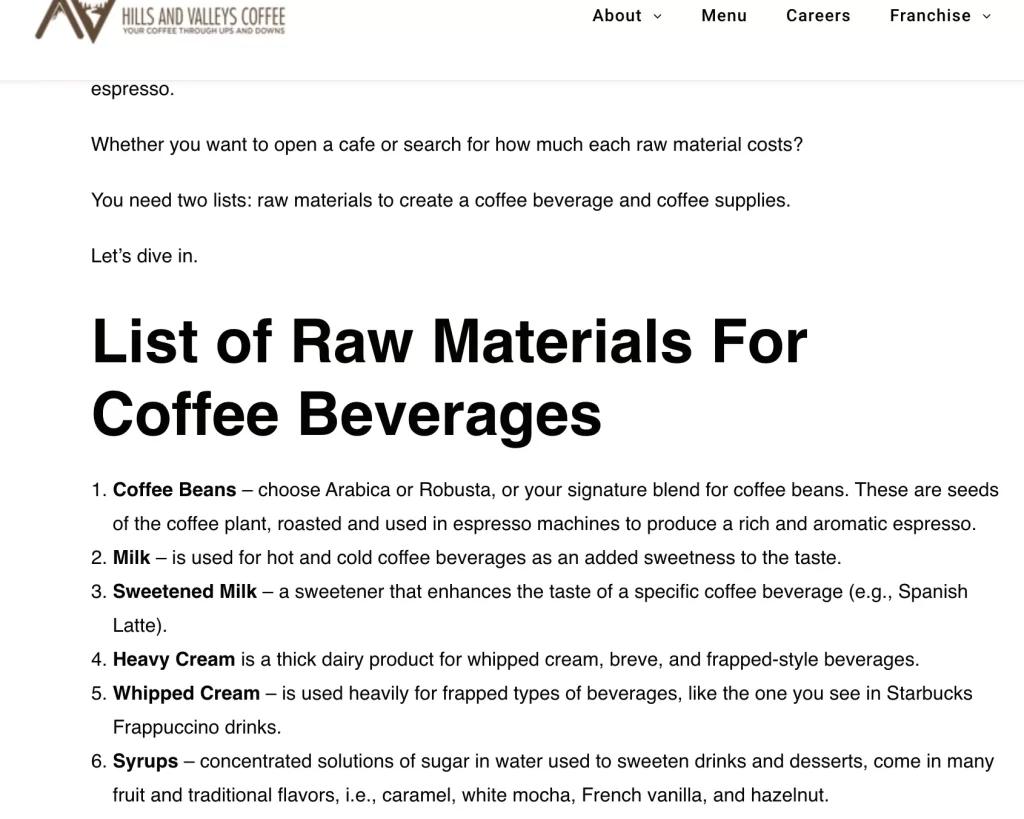
We’ve covered major topics related to starting and running a coffee shop, which has helped us rank for primary keywords and bring in thousands of search traffic every month.
Our content assets are tied directly to our core service—coffee franchising packages, and focus on serving our audience with this well-defined content theme.
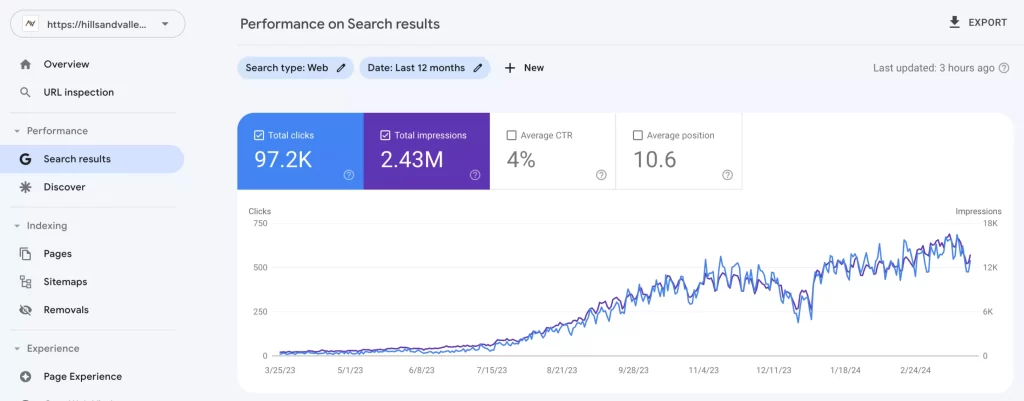
How will this content strategy attract links?
Reasons why it works:
- It helps you rank for keyphrases other content creators are searching for to find references to their content, which increases the chance of getting links from these publishers’ new content.
- It establishes unique differentiation among many others, making you a go-to source for niche topics you’re an expert in.
- It assists in acquiring multiple resource links from new (and even established) publishers who don’t have high-level expertise on the subject but want to enhance content credibility by referencing others.
Demonstrate First-Hand Knowledge
Cyrus Shepard from Zippy published a case study on some of the winning and losing sites after Google updates. It reveals some on-page elements strongly associated with improved search traffic.
First-hand knowledge and first-person pronouns are at the top of the list.
So, it is worth paying attention to these two elements when developing helpful content. It helps emphasize claims and points that other ranking pages haven’t covered yet, which sets your content apart.
Demonstrating firsthand knowledge and experience brings a new wealth of information to your target audience, a great way to position your brand as an expert in the industry.
Read sections of your content and assess where you can add first-hand experience as an industry practitioner. You may even ask colleagues and other experts in your organization for input to solidify information in your content.
Include “pro-tip” sections to share unique applications on the topic area/s, adding more key takeaways for your audience.
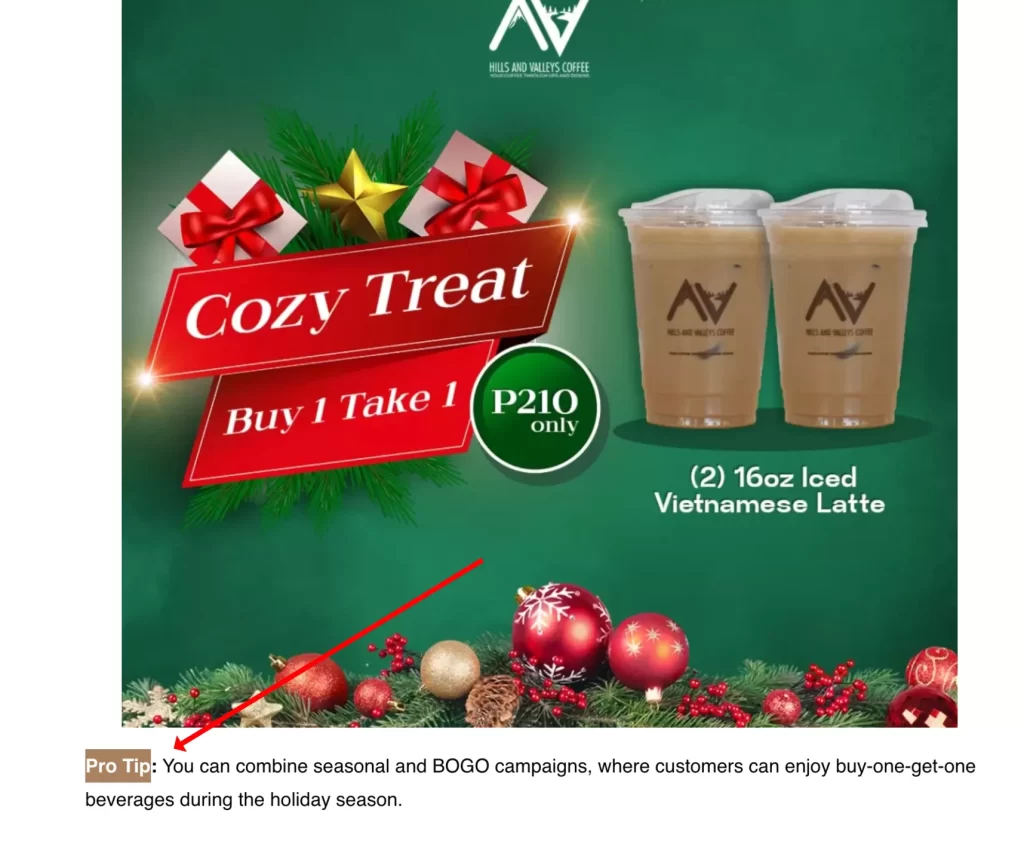
How will this content strategy get links?
Reasons why it works:
- It attracts hard-to-replicate links from reputable authors looking for more intermediate or advanced guides on the topics they write about.
- It gets links from the community audience of forums and user-generated sites referencing your content to support their claims.
- It appeals to curators, podcasters, and other creators looking for guests for interviews, podcasts, etc. You’ll likely be asked to appear and get links from published episodes on their sites.
Distribute Content Assets That Target Keyword Variations
Many SEOs have tried banking on authoritative sites' ability to rank pages quickly by distributing content regardless of the domain’s thematical relevance to their brands. Given the domain ranking capabilities of these high DR sites and established trust in search results, it quickly helps rank their pages.
Google recently demonstrated its stance on “quality trumps quantity” with new spam policies that try to counteract these manipulative actions.
Here’s a quick run-through of the new spam policies:
- Expired domain abuse - repurposing expired domains to piggyback on the domain’s age and authority.
- Scaled content abuse - mass-generating content resulting in tons of unoriginal, low-quality, and unhelpful content.
- Site reputation abuse - publishing third-party pages to take advantage of domain ranking signals and quickly rank these pages on search results.
It’s important to consider the thematic relevance of the distributed content assets.
Consider the types of sites you want your brand to associate with, assessing their targeted audience and weighing their ability to drive referral traffic (when these referred visitors find relevant links to your site to click on).
Start the content distribution process by Identifying keyword variations related to the primary keywords where your pages on your own site are currently ranking.
Use them as subtopics when distributing content assets on other sites.
How will this content strategy get links?
Reasons why it works:
- The strategy itself helps acquire contextual links from the site’s referring page.
- It boosts the ranking power of your destination page (if it’s an informational page, it increases its chance to rank for its keyword variations, which would passively attract new links from other publishers).
- It helps build your site’s topical authority (through off-page signals), improving its ranking capability to help climb other content in Google’s SERPs.
How do you qualify sites to get HCU-compliant backlinks?
The typical, old-school process for qualifying backlink prospects still works effectively: relevance, trust, and authority.
With link intelligence tools like Ahrefs, Open Site Explorer, and Moz, we could assess metric numbers at a glance. Some of these primary data points include:
- Backlink quality
- Traffic relative to the other sites in the space
- Keyword visibility and current organic traffic
- Quality of content
Remember, with so many core updates these days looking into site link quality, one metric isn’t enough to conclude a site's viability to provide ranking power to your target pages.
As such, we even have different link metrics for various clients we service with our link building services. We customize the link building campaign depending on their in-house link building requirements and target audience segments (when assessing how relevant backlink prospects are to the site).
In addition to the standard link qualification process, we acquire links from business sites that genuinely provide products/services. We limit getting links from affiliate sites (as HCU and product review affiliate updates hit most of these sites).
If you need help getting HCU-compliant backlinks, hop on to our strategy call today.
